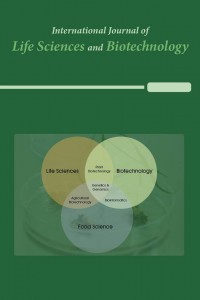Investigation of antioxidant activity and antiurease, anticollagenase enzyme inhibition profile of oleaster seeds
Investigation of antioxidant activity and antiurease, anticollagenase enzyme inhibition profile of oleaster seeds
___
- 1. Porter, C.T., Bartlett, G.J., Thornton, J.M., The catalytic site atlas: a resource of catalytic sites and residues identifed in enzymes using structural data, Nucleic Acids Research, 2004. 32, 129-133.
- 2. Lubbers, M.W., Rodrigues, S.B., Honey, N.K., Thornton, R.J., Purification and characterization of urease from Schizosaccharomyces pombe. Canadian Journal of Microbiology, 1996. 42:132-140.
- 3. Demiray, E., Yılmaz, O., Helicobacter Pylori İnfeksiyonunda Üreaz Enziminin Rolü ve Önemi, Türk Mikrobiyoloji Cemiyeti Dergisi, 2007. 37, 112- 117.
- 4. Arı, A., Histolojik Olarak Mide Kanseri İle Helicobacter Pylori Arasındaki İlişki, T.C. Sağlık Bakanlığı İstanbul Eğitim Hastanesi II. Genel Cerrahi Kliniği, Uzmanlık tezi, İstanbul, 2006.
- 5. Dinç, Y., Üreaz Enziminin Bazı Tıbbi Bitkiler Tarafından İnhibisyonu. İstanbul Üniversitesi, Fen Bilimleri Enstitüsü, Yüksek Lisans Tezi, pp. 90, İstanbul, 2009.
- 6. Sökmen, B. B., Aydın, S., Şahin, Y., Akyurt, İ., Üreaz ve Elastaz Aktivitelerine Giresun’dan Toplanan Cystoseira barbata (Stackhouse) C. Agardh Deniz Yosununun İnhibisyon Etkisinin İncelenmesi. Karadeniz Fen Bilimleri Dergisi, 2016. 6(14), 124-131.
- 7. Mahernia, S., Bagherzadeh, K., Mojab, F., Amanlou, M., Urease inhibitory activities of somecommonly consumed herbal medicines, Iranian Journal of Pharmaceutical Research, 2015. 14, 943–947.
- 8. Calleja-Agius, J., Brincat, M., Borg, M., Skin connective tissue and ageing. Best Practice and Research Clinical Obstetrics and Gynaecology, 2013. 27(5), 727-740.
- 9. Thring, T. S., Hili, P., Naughton, D. P., Anti-collagenase, anti-elastase and antioxidant activities of extracts from 21 plants. BMC Complementary and Alternative Medicine, 2009. 9, 27.
- 10. Sindhi, V., Gupta, V., Sharma, K., Bhatnagar, S., Kumari, R., Dhaka, N., Potential applications of antioxidants–A review. Journal of pharmacy research, 2013. 7(9), 828-835.
- 11. Van Slyke, D.D.E., Archibald,R.M., Manometric, titrimetric and colorimetric methods for measurement of urease activity, Journal of Biological Chemistry, 1944. 154: 623-642.
- 12. Almeida, A.R., Maciel, M.V.O.B., Machado, M.H., Bazzo, G.C., Armas, R.D., Vitorino, V.B., Vitali, L., Block, J.M., Barreto, P.L.M., Bioactive compounds and antioxidant activities of brazilian hop (Humulus Lupulus L.) extracts. International Journal of Food Science and Technology, 2020. 55, 340–344.
- 13. Matsubara, S., Shibata, H., Ishikawa, F., Yokokura, T., Takahashi, M., Sugimura, T., Wakabayashi, K., Suppression of Helicobacter pylori induced gastiritis by green tea extract in mongolian gerbils. Biochemical and Biophysical Research Communications, 2003. 310: 715-719.
- 14. Yang, S. W., Ho, J. N., Lee, Y. H., Sin, D. H., Hong, B. S., Cho, H.Y., Isolation and characterization of Helicobacter pylori urease inhibitor from Rubus coreanus. Journal of Korean Society Food Science and Nutrition, 2004. 33: 767-777.
- 15. Boran, R., Aysel, U., Saraç, N., Investigation of hyaluronidase, collagenase and elastase inhibitory potentials and comparative evaluation of the antimicrobial, antioxidant and homeostatic activities of two natural polysaccharides. Süleyman Demirel Üniversitesi Fen Bilimleri Enstitüsü Dergisi, 2018. 22(3), 1182-1189.
- 16. Ilhan, M., Zengin, G., Küpeli Akkol, E., Aktümsek, A., Süntar, I., The importance of Asphodeline species on enzyme inhibition: anti-elastase, anti-hyaluronidase and anti-collagenase potential. Turk. J. Pharm. Sci, 2016. 13, 323-327.
- 17. Sumantran, V.N., Kulkarni, A.A.,Harsulkar, A., Wele, A., Koppikar, S.J., Chandwaskar, R., Gaire, V., Dalvi, M., Wagh, U.V., Hyaluronidase and collagenase inhibitory activities of the herbal formulation Triphala guggulu, Journal of Biosciences, 2007. 32, 755-761.
- 18. Kumar, R. V., Chauhan, S., Mulberry: Life enhancer, Journal of Medicinal Plants Research, 2008. 2, 271-278.
- 19. Mahomoodally, F., Utilisation of Rhododendron luteum Sweet bioactive compounds as valuable source of enzymes inhibitors, antioxidant, and anticancer agents. Food and Chemical Toxicology,2020. 135-111052.
- 20. Kashyap, P., Shailza, A. ve Abhimanyu, T., Evaluation of Antioxidant and Antimicrobial Activity of Rhododendron arboreum Flowers Extract, International Journal of Food and Fermentation Technology,2017. 123-128.
- Yayın Aralığı: Yılda 3 Sayı
- Başlangıç: 2018
- Yayıncı: International Society of Academicians
Cancer Suppression by Lymphocytes Activated by Cancer-Mediated Exosomes: an In Vitro Study
Aysegul YILMAZ, Irmak FERAH OKKAY, Ali TAGHİZADEHGHALEHJOUGHİ
Sk Injamamul ISLAM, Moslema Jahan MOU, Saloa SANJİDA, Md. SAROWER-E-MAHFUJ, Md. Ashraful ALAM, Yeasmin ARA
Assessment of Food Safety During Covid-19 Pandemic
Cennet Pelin BOYACİ GUNDUZ, Mehmet Fatih CENGİZ
Özlem BAKIR, Esabi Başaran KURBANOĞLU
Melisa BEYHAN YILMAZ, Fahriye ZEMHERİ NAVRUZ, Ecem SEÇGİNLİ
Çeşitli evsel atıkların Aureobasidium pullulans tarafından melanin sentezinde kullanılması
Plant Attractants and Rewards for Pollinators: Their Significant to Successful Crop Pollination
Nur Athirah ZARİMAN, Nurul Alia OMAR, A. NURUL HUDA
Firdausi ALİYU, Aliyu ADAMU, Roswanira AB. WAHAB, Fahrul ZAMAN HUYOP
Hatice Aysun MERCİMEK TAKCI, Sema GENÇ, Ayşenur YALÇIN, Eda ÖZDEMİR
